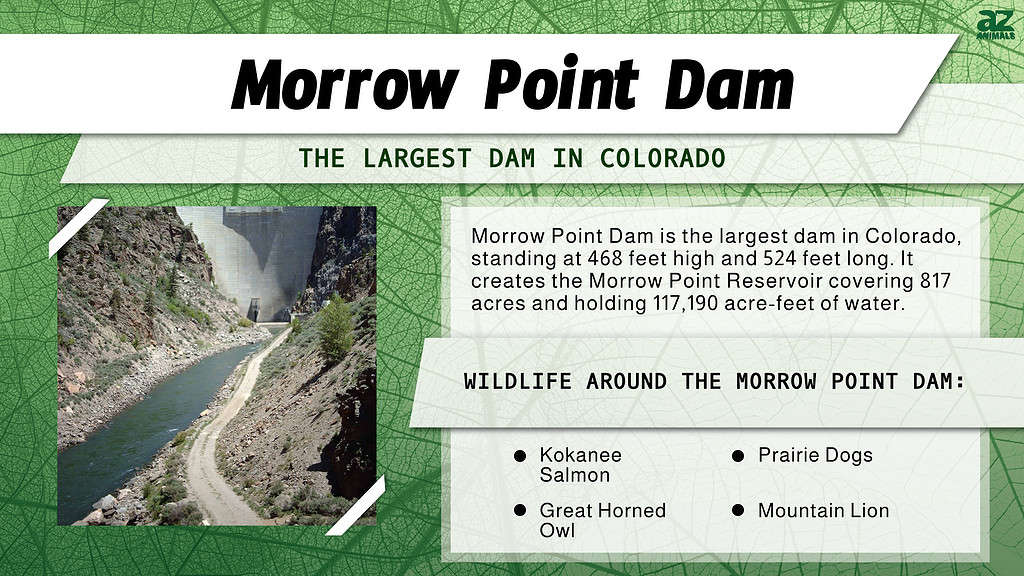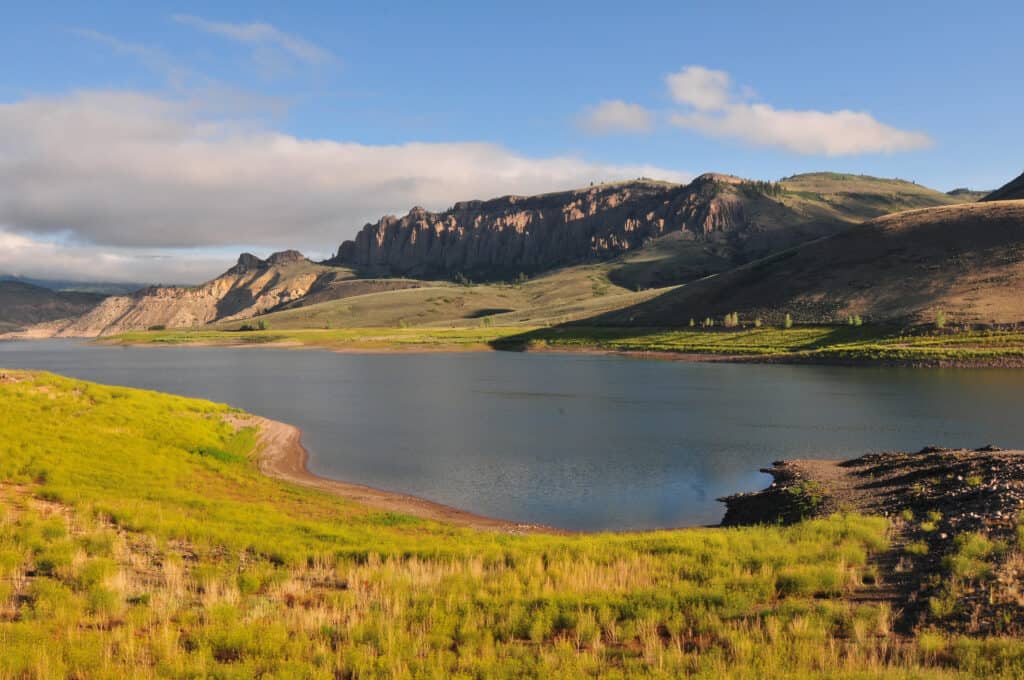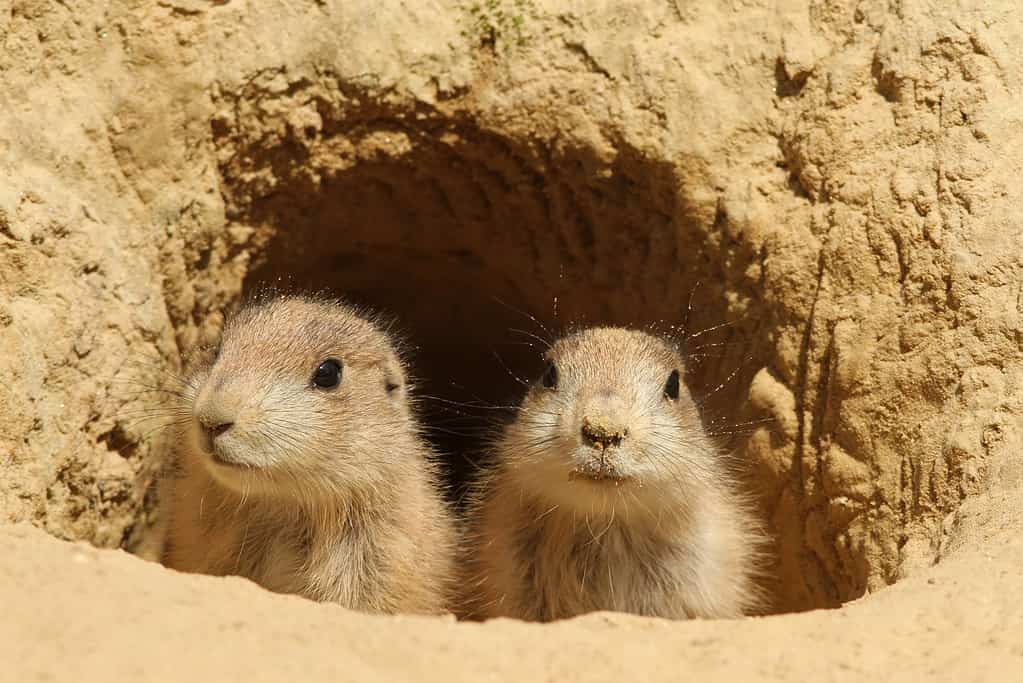Standing at a height of 468 feet, Morrow Point Dam is twice as tall as Niagara Falls. It’s also the first double arch design of its kind built in the United States. Plus, the 12-mile-long reservoir it creates offers countless opportunities for wildlife viewing and fun! Join us as we explore the biggest dam in Colorado and the waters around it.
What’s the Largest Dam in Colorado?

The largest dam in Colorado is Morrow Point Dam which stands 468 feet high and 524 feet long. The crest is 720 feet long. This engineering first for the United States, was the country’s first double-curvature arch dam. Watching the waters drop over 300 feet from the dam’s spillway is an exciting event to witness.
Morrow Point Dam is located in the Black Canyon of the Gunnison River, a 2,460-foot-deep gorge. It’s a part of the Curecanti National Recreation Area. The dam was constructed by the Bureau of Reclamation as part of the Upper Colorado River Storage Project. It’s here that Morrow Point serves as an important source for hydroelectric power generation. The power plant houses two generators, each with a capacity of 86.667 megawatts. During the irrigation season, the powerplant functions as a base load plant, while it provides peaking power during other seasons.
Morrow Point Reservoir

Morrow Point Dam is located in the Black Canyon of the Gunnison River, a 2,460-foot-deep gorge.
©LHBLLC/Shutterstock.com
The Morrow Point Reservoir has a total capacity of 117,190 acre-feet and covers an area of 817 acres. The impressive waters offer breathtaking scenery throughout its entire 12-mile stretch. The reservoir offers fishing guide services and scenic boat tours. The river coming out of the dam is rough and fast but slows down as it travels further downstream.
Anglers can expect to catch kokanee salmon, rainbow, brown, and lake trout. While hikers can enjoy exploring the narrow cannon while on Pine Creek Trail. Morrow Point Reservoir is part of the Black Canyon, which was formed by ice and rock flooding through the canyon over millions of years. Pine Creek Trail provides access to the river, a few miles from the Lake Fork/Highway 92 turnoff, on the canyon side of Highway 50. This advanced trail has more than 225 steps descending into the canyon.
A Part of Curecanti National Recreation Area

The Curecanti National Recreation Area has a remarkable landscape and wildlife scene, including winter elk.
©Bernadette Heath/Shutterstock.com
Curecanti National Recreation Area has an unforgettable landscape with rugged mesas and canyons. The area was inhabited by Ute Indians about 10,000 years ago. In more recent times, the Denver & Rio Grande Railroad operated in the area from 1882 to 1949.
Curecanti was officially established as a national recreation area on February 6, 1965. Today, the park offers educational programs, visitor centers, hiking trails, camping facilities, picnic areas, and even hunting.
Morrow Point Dam is one of three important dams in the Curecanti Area. There were originally going to be four dams, but decision-makers found the fourth to be uneconomical. The three dams in action now are the Blue Mesa, Crystal, and Morrow Point Dam.
Blue Mesa Dam
Morrow Point is about 12 miles downstream from Blue Mesa Dam. Blue Mesa Dam is also on the Gunnison River, around 30 miles below Gunnison. This dam’s reservoir has a total capacity of 940,700 acre-feet and an active capacity of 748,430 acre-feet. At maximum water surface elevation, the reservoir covers 9,180 acres.
The geological makeup in the area includes ancient rocks like granite, gneiss, and schist at the base, followed by layers of sandstone, shale, and clay. Blue Mesa’s bed was formed from less-resistant volcanic mudflow materials, resulting in tall striking spires. These types of spires are common in canyons, badlands, and volcanic terrains.
Crystal Dam
Crystal Dam is about 6 miles downstream from Morrow Point Dam. This might not be the biggest dam in Colorado, but it still has an impressive history. They say it took 1,000 workers a total of five years to construct Crystal Dam.
Built on Precambrian metamorphic rocks, this double-curvature thin-arch type dam, stands at a height of 323 feet, with a crest length of 620 feet. The crest is 1 foot above the normal water surface at an elevation of 6,756.0 feet. Crystal Dam’s reservoir has a total capacity of 25,236 acre-feet and an active capacity of 12,891 acre-feet at an elevation of 6,700 feet. It covers a surface area of 301 acres.
Nature’s Emergency Exit

Dam spillways help control excess water from heavy rain.
©Bryan Busovicki/Shutterstock.com
If you ever get a chance to see Morrow Point Dam during a spillway opening, you’re in for a treat. Imagine watching the water cascading 350 feet. It’s a rare event, and one you’ll never forget.
Other than looking amazing, what’s the purpose behind spillways? It turns out they’re the special backup plan for when water levels go awry.
When water needs an emergency exit, spillways save the day. Dams are all about keeping water in one place. The water they store can help with electricity generation, irrigation, and flood control. As long as the dam’s built correctly and the water’s behaving, it’s a pretty easy gig. But sometimes things don’t go as planned.
Every now and then, the weather acts up, and water levels get dangerously high. That’s why, most dams have at least one spillway, while large dams typically have two; a service spillway and an emergency spillway. If it starts pouring and water levels get too high, the spillways can provide a fast exit.
There are a lot of different designs for spillways. For instance, the Crystal Dam’s spillway features an ungated ogee crest on the right side and a plunge pool at the dam’s toe.
Wildlife Living Around Morrow Point Reservoir

There are a lot of adorable prairie dogs living around Colorado’s largest dam.
©Henk Bentlage/iStock via Getty Images
What type of wildlife might you see around Morrow Point Dam? Gunnison River and its surrounding areas are home to all sorts of creatures. For instance, Canada Lynx were reintroduced to the state of Colorado by Colorado Parks and Wildlife and live through the spruce-fir trees in the Gunnison National Forest. There’s also the yellow-bellied marmot, a big golden brown rodent that hides out in burrows or on top of rocks.
Who else might you see? Here are a few exciting species you can see roaming the woods or flying through the skies around Colorado’s largest dam:
- Beavers
- Moose
- Canada Lynx
- Bobcat
- Mountain Lion
- Black Bear
- Juniper Titmouse
- Bushtit
- White-Breasted Nuthatch
- Mountain Chickadee
- Osprey
- Peregrine Falcon
- Prairie Falcon
- Northern Goshawk
- Cooper’s Hawk
- Sharp-Shinned Hawk
- Red-Tailed Hawk
- American Kestrel
- Turkey Vulture
- Belted Kingfisher
- Northern Harrier
- Great Horned Owl
- Long-Eared Owl
- Bald Eagles
- Short-Eared Owl
- Northern Saw-Whet Owl
- Common Merganser
- Rocky Mountain Elk
- Beavers
- Whooping Crane
- Great Blue Heron
- Dusky Grouse
- Western Burrowing Owls
- Prairie Dogs
- Gunnison Sage Grouse
- Golden Eagle
Gunnison River has a thriving prairie dog population running around. These clever critters have to survive in a world where predators are always around the corner. Birds of prey are especially fond of them, and so are their young. About 75% of the golden eagle chick’s diet consists of prairie dogs. Golden eagles, bald eagles, ospreys, peregrine falcons, and prairie falcons are all birds of prey that can be found in the area.
The photo featured at the top of this post is © Alexander Lukatskiy/Shutterstock.com
Thank you for reading! Have some feedback for us? Contact the AZ Animals editorial team.







